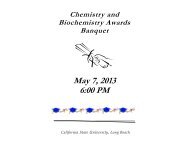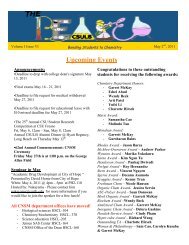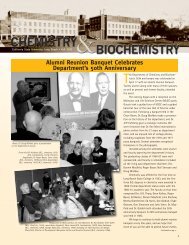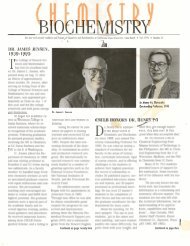2011 - California State University, Long Beach Department of ...
2011 - California State University, Long Beach Department of ...
2011 - California State University, Long Beach Department of ...
You also want an ePaper? Increase the reach of your titles
YUMPU automatically turns print PDFs into web optimized ePapers that Google loves.
By Anne Ambrose<br />
Weers Lab Looks at Lipids<br />
Lipids, or fats, play an essential role in providing energy to organisms, and it’s the mechanism <strong>of</strong><br />
how lipids are transported through the blood to cells that intrigues Paul Weers, associate<br />
pr<strong>of</strong>essor <strong>of</strong> biochemistry.<br />
Animals accomplish this transport<br />
by means <strong>of</strong> large lipoprotein<br />
complexes, made up <strong>of</strong> lipids and<br />
small proteins called<br />
apolipoproteins.<br />
”We work on exchangeable<br />
apolipoproteins from insects,<br />
which we call apolipophorins to<br />
distinguish them from vertebrate<br />
apolipoproteins,” Weers explained.<br />
Apolipophorins, which were<br />
discovered about 30 years ago,<br />
include the protein studied by<br />
Weers, apolipophorin III. “We use<br />
this protein as a model system Dr. Paul Weers<br />
because <strong>of</strong> the availability <strong>of</strong> three-dimensional structures,” since there is limited high-resolution<br />
structural information available for human apolipoproteins. “Since we know the exact position <strong>of</strong><br />
each amino acid in the protein, we are able to carry out structure-guided, site-directed mutagenesis<br />
to address fundamental and practical questions related to apolipoprotein function.<br />
“One aspect <strong>of</strong> our research is to understand how apolipoproteins bind to lipids,” he continued.<br />
“The resulting lipoprotein particles transport hydrophobic materials such as diacylglycerol, phospho -<br />
lipids and cholesterol through the blood. You need to have lipids in soluble form, and that’s why the<br />
assembly <strong>of</strong> lipid/protein complexes is required for transport to cells.”<br />
With a four-year grant from the National Institutes <strong>of</strong> Health, Weers explores the protective<br />
role apolipoproteins play against bacterial infection. “Lipopolysaccharides are membrane components<br />
<strong>of</strong> gram-negative bacteria; their release in the blood <strong>of</strong>ten results in septic shock. There are treatments<br />
available, but those can be improved. We are investigating how apolipoproteins can help because<br />
they are circulating in the blood and associate with the toxic lipopolysaccharides.”<br />
A related project is examining the ability <strong>of</strong> apolipophorin III to lyse bacteria. “Our protein has a<br />
high affinity for negatively charged phospholipids, which are abundant in bacterial membranes. We<br />
think that our protein has antimicrobial activity, and we’re currently exploring that possibility.”<br />
Weers earned his Ph.D. in the biochemical physiology research group at Utrecht <strong>University</strong> in<br />
the Netherlands. He then began postdoctoral work in the <strong>Department</strong> <strong>of</strong> Biochemistry at the<br />
<strong>University</strong> <strong>of</strong> Alberta, Edmonton, Canada. He came to northern <strong>California</strong> when his pr<strong>of</strong>essor moved<br />
the research lab to the Children’s Hospital Oakland Research Institute in the Bay Area. He joined<br />
CSULB as an assistant pr<strong>of</strong>essor in spring 2003.<br />
And Weers continues to collaborate with several Canadian researchers. He and Robert Kiss <strong>of</strong><br />
McGill <strong>University</strong>, Montreal, characterized a mutant protein <strong>of</strong> apolipoproteinA-I in a patient with<br />
abnormally low HDL levels, and their study was published in September 2010 in the Journal <strong>of</strong> Lipid<br />
Research (J. Lipid Res., <strong>2011</strong>. 52: 35-44; www.jlr.org). He also spent spring 2010 on sabbatical, working<br />
with Elmar Prenner at the <strong>University</strong> <strong>of</strong> Calgary on isothermal titration calorimetry—experience he<br />
now can apply in using CSULB’s new calorimeter.<br />
Weers finds it very rewarding to work with students. The ability to train students in all aspects<br />
<strong>of</strong> scientific research is a huge motivator, and they have contributed tremendously to the lab. Duc Le,<br />
a biochemistry student in his lab, won the CSULB <strong>2011</strong> Outstanding Undergraduate Research<br />
Student Award. Weers received the 2010 CNSM Faculty Award for Excellence, also known as the<br />
“Pretty Darn Good Pr<strong>of</strong>essor Award,” followed this spring by the CSULB Distinguished Faculty<br />
Scholarly and Creative Achievement Award.<br />
Photo by Victoria Sanchez<br />
CSU Faces<br />
More Budget Cuts<br />
The <strong>California</strong> <strong>State</strong> <strong>University</strong> system is facing<br />
another year <strong>of</strong> budget cuts. In Sacramento,<br />
the early months <strong>of</strong> <strong>2011</strong> were consumed by<br />
partisan disagreements over the budget. Governor<br />
Jerry Brown proposed a referendum on extending<br />
the higher sales and income tax rates that had been<br />
in effect since 2009. However, all tax increases<br />
require a two-thirds majority in both chambers <strong>of</strong><br />
the legislature, and Brown was unable to attract<br />
any Republican support for his proposal. As a 2010<br />
voter-approved ballot proposition allows the legislature<br />
to pass a budget lacking tax increases on a<br />
simple majority vote, an “all-cuts” budget was<br />
drawn up and passed by the Demo crats, who hold a<br />
majority in both chambers.<br />
The budget imposes sharp reductions on many<br />
areas <strong>of</strong> state spending, including cuts to higher education.<br />
The <strong>University</strong> <strong>of</strong> <strong>California</strong> and the CSU received<br />
cuts <strong>of</strong> $650 million each, amounting to 22 and 25 percent,<br />
respectively, <strong>of</strong> their total state support.<br />
The budget assumes that tax revenues will be<br />
$4 billion higher in <strong>2011</strong>-12 than in 2010-11. If this<br />
increase does not materialize by January, an additional<br />
$100 billion will be cut from the CSU, an<br />
additional 4 percent cut.<br />
The effects <strong>of</strong> the cuts will be <strong>of</strong>fset by a number<br />
<strong>of</strong> factors. First, the CSU trustees have approved<br />
a 22 percent increase in student fees. With this<br />
increase, CSU students for the first time will be paying<br />
most <strong>of</strong> the cost <strong>of</strong> their education—about 57<br />
percent—with only 43 percent coming from the<br />
state. CSU fees have more than tripled since 2001.<br />
Additionally, a budget restoration near the end<br />
<strong>of</strong> 2010 came so late in the academic year that some<br />
funds remained unspent and are being carried over<br />
to this year. At CSULB, these carryover funds will be<br />
used to mitigate the effects <strong>of</strong> the cuts this year.<br />
Our campus still plans on <strong>of</strong>fering all classes that<br />
students need to progress toward graduation. But<br />
the carryover funds will be consumed this year and<br />
will not be available to mitigate any continued cuts<br />
for 2012-13.<br />
The cuts are being felt in many ways. Many<br />
faculty are carrying higher teaching loads. There is<br />
less money available for purchase and maintenance<br />
<strong>of</strong> instructional equipment, faculty and student<br />
travel, and matching funds for external grants. New<br />
faculty hiring has been sharply reduced. Programs<br />
like the <strong>University</strong> 100 orientation for entering<br />
freshmen and the annual Odyssey program, where<br />
CSULB welcomed visitors from the community, are<br />
now just fading memories, as are pay raises for faculty<br />
and staff.<br />
We can only hope that an economic recovery is<br />
ahead—and not too far ahead. Meanwhile, the CSU<br />
needs to be resourceful in order to do our best to<br />
serve students and maintain the quality <strong>of</strong> our university<br />
system.<br />
5


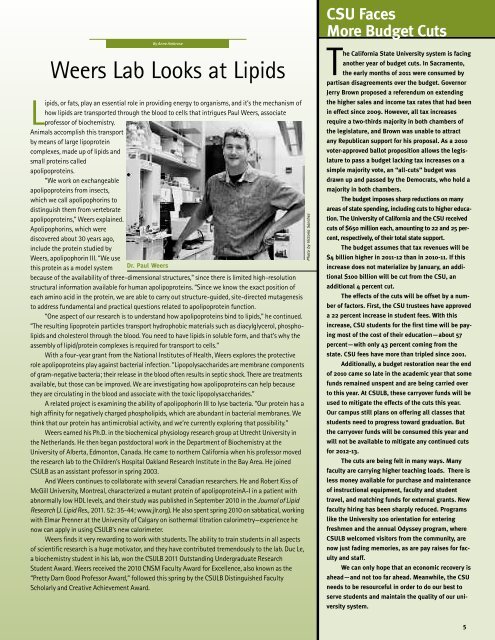
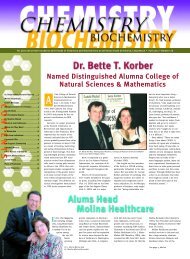
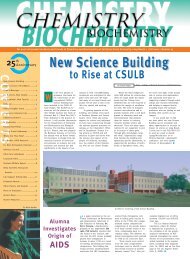
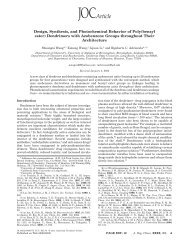
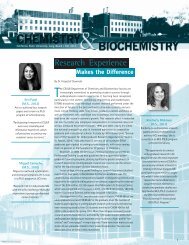
![Volume 4, Issue 3 [November 2012 pdf] - California State University ...](https://img.yumpu.com/34605825/1/190x245/volume-4-issue-3-november-2012-pdf-california-state-university-.jpg?quality=85)
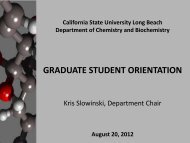
![Volume 5, Issue 2 [April 2013 pdf] - California State University, Long ...](https://img.yumpu.com/33273195/1/190x245/volume-5-issue-2-april-2013-pdf-california-state-university-long-.jpg?quality=85)
